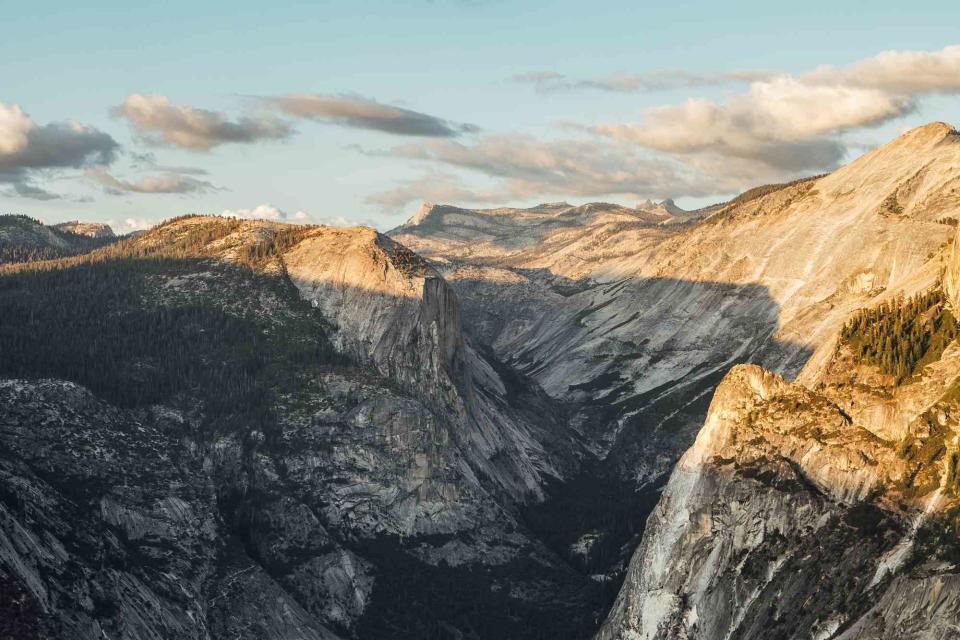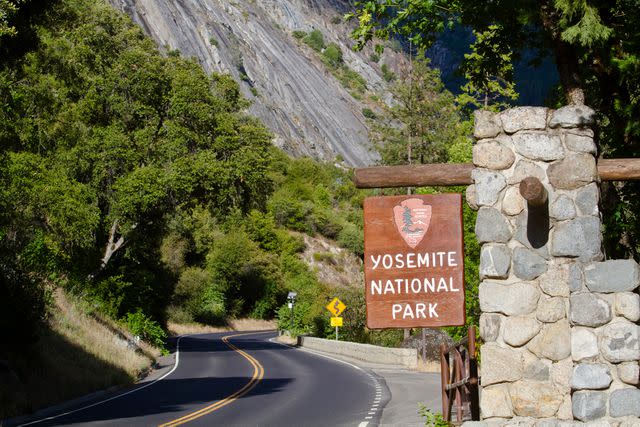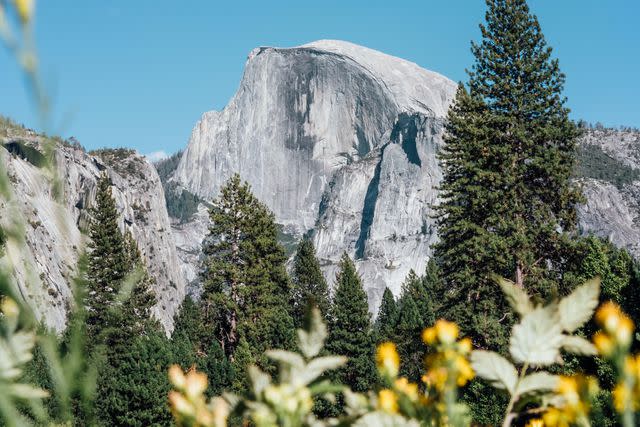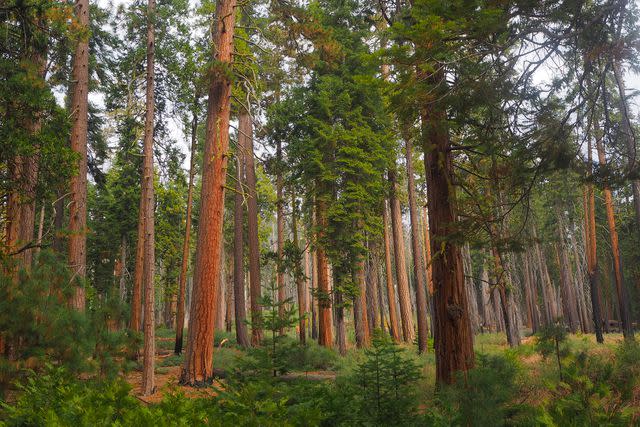How to Plan the Perfect Trip to Yosemite National Park, According to Naturalists and Park Experts
Here’s everything you need to know before planning a trip to Yosemite National Park.

Irjaliina Paavonpera/Travel + Leisure
Known around the globe for its majestic granite monoliths and overwhelming beauty, Yosemite National Park earned its status as a UNESCO World Heritage Site back in 1984. Yosemite boasts five of the planet's tallest waterfalls, pristine streams, three sequoia groves, picturesque meadows, and rich biological diversity. As one of the first national parks, Yosemite helped pave the way for the National Park System, and over its sprawling 1,200 square miles — equivalent to the size of Rhode Island — the park offers abundant activities and experiences.
“There are over 1,500 different species of plants in Yosemite. That's something many people don't think about when they come to Yosemite because the geography gets all the glory. The towering cliffs and Half Dome and El Capitan, and these giant waterfalls that tumble off them,” Cory Goehring, lead naturalist at the Yosemite Conservancy, said in an interview with Travel + Leisure. “But what excites me as a naturalist, and I think what other people should pay more attention to in the park, is the diversity of life.”
To enjoy all Yosemite has to offer, here are important things you should know, including logistics, trails, and places to stay, informed by three experts who intimately understand Yosemite in different ways — and love it all the same.
Meet the Experts
Cory Goehring is the senior naturalist for the Yosemite Conservancy and has lived in and loved the park for 17 years.
Mike Augustine is a T+L A-list advisor and U.S. national parks specialist.
Mikah Meyer visited 419 U.S. National Park Service sites on a three-year road trip, becoming the first person to accomplish this on a single journey.
Planning Your Visit

Valerie de Leon/Travel + Leisure
A standard entrance pass costs $20-35, depending on whether you enter on foot, motorcycle, or in a private vehicle with fewer than 15 passengers. The pass covers everyone inside the vehicle and is valid for seven consecutive days. An annual entrance pass that costs $70 grants access to Yosemite for 12 months. The park is open year-round, though certain roads, like Tioga Road and Glacier Point Road, close for the winter season due to snow.
Driving into or through Yosemite requires a reservation from April 13 through Oct. 27, with a few exceptions:
From April 13 through June 30, you need a reservation only on weekends and holidays.
From July 1 through Aug. 16, you need a reservation every day of the week.
From Aug. 17 through Oct. 27, you need a reservation only on weekends and holidays.
Reservations cost $2 each — a small price for the significant benefit of limiting vehicle congestion, but securing one can be tricky during peak months.
“They're sort of like buying concert tickets with how popular that park is. You have to be on your game to get up during these times,” said Augustine. “They release a big batch of them early in the year, and then every day around 8 a.m., the national park releases more, so if you get on early enough in the day, you can get a permit for the peak hours.”
Find tickets on recreation.gov.
How to Get There

Mark Miller Photos/Getty Images
Yosemite has five main entrances:
Hetch Hetchy Entrance: Access this seasonal entrance via Highway 120, which traverses the park.
Big Oak Flat Entrance: This is off Highway 120 and an easy entry point if you’re coming from the Bay Area.
Arch Rock Entrance: If you're coming in the wintertime, opt for this all-year entrance off Highway 140. “That is the lowest elevation entrance into the park,” Goehring said. At higher elevations, you’re more apt to encounter tricky winter conditions.
South Entrance: This entry point works best if you're driving from San Diego or Los Angeles.
Tioga Pass Entrance: This eastern entrance is accessible via Highway 120 and is open May through October. “That is probably my favorite entrance because I'm a bit biased towards the higher elevations of the park,” said Goehring.
If you’re flying, “Fresno, San Francisco, or Oakland are probably the best places to arrive,” Augustine said. Once you park in Yosemite Valley, you can take the free shuttle throughout the day and avoid driving around the park.
You can also take public transportation, which many people don’t realize.
“If you take public transportation into the park, you do not need to have a reservation,” Goehring said. Yosemite Area Regional Transport System, or YARTS, runs year-round on Highway 140 from Merced, California, in the Central Valley, into the park. It also has seasonal routes. You can stay at one of the gateway communities (like Merced, Mariposa, Midpines, and El Portal) and hop on at one of the many YARTS stops. YARTS also connects with Amtrak and Greyhound.
“[YARTS] is a great way to come into the park because one of the frustrations people have is that it can be hard to find a parking spot when there's no permit,” Goehring said. Additionally, “You get to look out the window the entire way, and you don't have to worry about driving the winding roads.”
Best Time to Visit

Irjaliina Paavonpera/Travel + Leisure
What’s the best time to visit Yosemite? Goehring gets this question a lot and has an unexpected answer: “I think what people are looking for whenever they ask this question is a time when the weather is quote-unquote 'good.' But I think Yosemite has the best character whenever it's about to snow or rain. People think, ‘Oh, that's when the weather is bad,’ but that's when Yosemite is so amazing,” he said. “The pictures that I put on my desktop backgrounds or on my phone are not the beautiful sunny days of Yosemite; it's the days that are kind of gray and the clouds are moving across the cliffs.”
Winter and early spring are some of Goehring’s favorite times to visit the park, and indeed, a surprise snowstorm can create spectacular scenes. If you visit Yosemite during the winter, be sure to monitor weather conditions, which can be unpredictable, and come prepared with chains on your tires. That said, those moody days deliver.
“The day after a heavy rainstorm, you come out in the morning, and the fog is lifting out of the valley. The clouds are grazing the face of Half Dome; those are amazing,” Goehring said. “It takes a little more planning, but those are some of the most magical times in Yosemite.”
He also acknowledges that nothing beats the middle of July when it's 115 degrees in the Central Valley of California, but at 10,000 feet in the Tuolumne Meadows, it’s 75 degrees and sunny and the flowers are blooming.
Ultimately, the best time to visit depends on what you’re after. Augustine recommends spring if you’re chasing waterfalls and wildflowers, though high passes and viewpoints might be closed if there’s still snow. “The waterfalls tend to be much fuller during the spring as the snow melts in the higher elevations, so you get beautiful waterfalls,” he said. For the best hiking, he recommends June to August, especially if you want to go to high alpine areas. Just note there will be greater crowds. They'll thin in the fall, and September is just as spectacular as July and August.
Meyers agrees but adds that the earlier in the summer you go, the less likely you are to encounter wildfire complications. “I hate to say that because August and September could be beautiful, but if this is like a once-in-a-lifetime trip, and you're getting your whole family together, you want to mitigate your risk of wildfires closing the park,” he said.
Best Things to Do

Valerie de Leon/Travel + Leisure
Explore Yosemite Valley.
"[Yosemite Valley’s] a must-see destination," Goehring said, highlighting this popular section of the park with iconic views of El Capitan, Half Dome, and Yosemite Falls. Yosemite Valley is also where you’ll find the welcome and exploration centers and access to many trails. Goehring suggests strolling through the meadows and along the river to fully appreciate the park's beauty.
An avid runner, Meyer echoes that sentiment, emphasizing the allure of the surrounding scenery. "It's not all about the peaks; it's not all about hiking to the top," he said, recommending you explore the 11.5-mile paved loop trail by foot or bike.
See giant sequoias in Mariposa Grove.
“We have three groves of giant sequoias here in Yosemite, and the Mariposa Grove is one of my must-see locations. It's a grove of over 500 mature giant sequoias. In a way, those sequoias helped birth the national park idea,” said Goehring. In 1864, Abraham Lincoln's Yosemite Land Grant protected Mariposa Grove and Yosemite Valley, laying the groundwork for the National Park System. Though not the first national park — Yellowstone holds that honor — Yosemite's preservation efforts played an instrumental role in shaping the National Park Service.
Watch the sunset at Glacier Point.
Experience a breathtaking sunset at Glacier Point, accessible via a 15-mile uphill drive that rises 7,000 feet in elevation. “It's easily accessible for wheelchairs and walkers. You can easily walk right out to the point and see straight down nearly 3,000 feet into Yosemite Valley,” said Goehring. Stay for twilight after the official sunset time for a prismatic experience. “Plan on staying at least 30 minutes,” said Meyer.
Drive to the Tunnel View.
“It's so basic, but the Tunnel View is just one of the most iconic views in the entire National Park System,” said Meyer. Take the Wawona Tunnel on Highway 41 and bask in glorious views of the valley, Half Dome, El Capitan, Yosemite Falls, and Bridalveil Falls. “Plan to take some time, pull over, and enjoy that view before you enter the Valley,” he said.
Take a guided hike.
Guided walks with a naturalist or park ranger offer in-depth insights into Yosemite's geological history and diverse ecosystem. If you’re short on time or unfamiliar with the area, a guide's expertise will dramatically enhance your Yosemite trip. “A guide can make your experience a little different than just going in and figuring it out on your own. Having someone knowledgeable makes the experience,” said Augustine.
Join an astronomy program.
Yosemite’s stargazing opportunities are out of this world. Expert-led astronomy programs, offered by organizations like Yosemite Conservancy, provide transformative perspectives amid the roar of Yosemite Falls and views of the Milky Way. Even without a formal program, you should marvel at the night sky — you might even witness phenomena like moonbows at Yosemite Falls during full moons. “There's a saying within the national parks that half the park is after dark,” Goehring said. “At night, the cosmic wilderness unveils itself.”
Best Hikes

Irjaliina Paavonpera/Travel + Leisure
Yosemite has no shortage of incredible hikes. The Yosemite Valley Loop Trail offers full- and half-loop options, spanning 11.5 miles or 7.2 miles, respectively. Experience lush forests, meadows, and picturesque footbridges across the Merced River. Cathedral Lakes Trail takes you to Yosemite’s alpine region on a 9.5-mile, out-and-back through Tuolumne Meadows. Mist Trail to Vernal Falls is a three-mile, round-trip trek to the majestic Vernal Falls. Sentinel Dome and Taft Point are gentle trails with beautiful vistas, and a small trail hidden behind Happy Isles Nature Center will bring you to The Fen, a serene area teeming with wildlife.
Goehring’s favorite trail is the demanding, yet rewarding, Four-mile Trail to Glacier Point and the Panorama Trail. “Hike up to Glacier Point, so you get that view. You get to climb out of the valley next to Sentinel Rock. And then you get to come back down the Panorama Trail over Illilouette Falls. And then you can either come back down the Mist Trail, which I don't recommend. Those stairs can be tough on your knees. But you can come back down the John Muir Trail. Even though it does add an extra mile, I think it's a little gentler and a better trail to come back down,” he said.
Of course, you could also enter the permit lottery to challenge any fear of heights with the iconic Half Dome Hike, a 14- to 16-mile round-trip hike where you’ll tackle the steep final ascent using metal cables installed on the dome's smooth granite face.
Wildlife and Natural Features
The bears in Yosemite might look like brown bears, but rest assured, they're black bears with brown fur. The park also has endangered great gray owls, peregrine falcons (the fastest animal on Earth), and Sierra bighorn sheep found at high elevations. “The Yosemite Conservancy helps fund a project to bring Sierra bighorns back into Yosemite. You can get lucky if you're up in the Tuolumne area,” said Goehring. Mountain lions also roam the area, though sightings are rare.
Additionally, Yosemite's rich plant life features more than 1,500 vascular plant species, including towering giant sequoias, the Yosemite bog orchid, which is only found in Yosemite National Park, beautiful blue lupine, and, at lower elevations, California poppy. In the summertime, at the highest elevations, you might find a unique flower called a sky pilot, which blooms only at high elevations.
Places to Stay

Tracy Barbutes/Courtesy of Firefall Ranch/Travel + Leisure
Château du Sureau
If you want equal amounts of luxury and adventure on your trip to Yosemite, head to Château du Sureau, a Relais & Châteaux property. This nine-acre country house resort evokes the South of France with 10 guest rooms and an uber-luxe 2,000-square-foot manor.
Firefall Ranch
A new rustic-chic retreat called Firefall Ranch near Yosemite's northwest entrance offers 55 cottages and villas on a spacious 300-acre property. Each accommodation features luxurious amenities like indoor/outdoor fireplaces and covered decks.
Tenaya Lodge
Situated outside the south entrance of Yosemite, Tenaya Lodge offers a variety of accommodations, plus three different restaurants, including a pizzeria. The Cottages feature private entrances, outdoor sitting areas, and fireplaces. For added privacy, you can opt for the Explorer Cabins, which offer two-bedroom accommodations with a cozy living room and a private deck.
Rush Creek Lodge
Near the northwest entrance at Big Oak Flat, Rush Creek Lodge offers cozy cabins and villas and an intimate lodging experience amidst Yosemite's natural beauty. “It's a great place for families, especially if you don't want to be in a bigger lodge,” said Augustine.
Upper and Lower Pines Campgrounds
Family-friendly and easily accessible, Upper and Lower Pines Campgrounds offer a communal atmosphere. “We get four million visitors a year from all over the world, so you can be camped right next to someone who flew from the other side of the world here,” said Goehring.
Camp 4
Listed on the National Register of Historic Places, Camp 4 is a first-come, first-served campground near Yosemite Falls and Yosemite Valley Lodge at 4,000 feet. Famous climbers like Yvonne Chouinard and Alex Honnold once pitched their tents on the 11-acre campground. For more camping options, check out T+L's guide to the best Yosemite campgrounds.
Places to Eat
Elderberry House Restaurant at Château du Sureau has maintained its status as the top fine dining destination in the region for more than three decades with its seasonally inspired menu and fine wines. Within the park, The Ahwahnee’s dining room has surreal views. “The best lodge and best restaurant in that area is the Ahwahnee,” said Augustine. He notes that securing reservations — for the restaurant and the accommodations — can be challenging due to its popularity, and the restaurant team prioritizes lodge guests for restaurant reservations.
If you’re not in the mood for fine dining, Goehring’s got you covered: “Pack a lunch and find a rock next to the river or an area that speaks to you and eat a peanut butter and jelly sandwich and just take it in. That's what it's all about. Maybe it'll be the best peanut butter and jelly sandwich you'll ever have, sitting next to the Merced River, listening to the red-winged blackbird chirp and hearing the crash of Yosemite Falls. That's the best table in the house, right?”
For more Travel & Leisure news, make sure to sign up for our newsletter!
Read the original article on Travel & Leisure.


